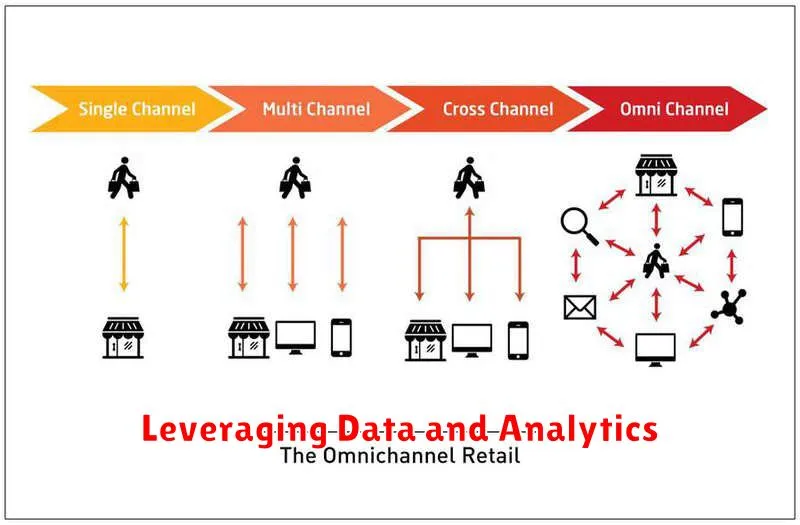In today’s dynamic retail landscape, staying ahead of the curve requires a comprehensive understanding of evolving consumer behavior and preferences. Multichannel retailing, once considered cutting-edge, is now being superseded by a more sophisticated approach: omnichannel retailing. This shift signifies more than just adding more channels; it represents a fundamental change in how retailers interact with customers, creating a seamless and integrated experience across all touchpoints. This article explores the key differences between multichannel and omnichannel strategies, delving into the core components of a successful omnichannel retail approach.
Moving beyond multichannel and embracing omnichannel offers significant benefits for retailers. From enhanced customer loyalty and increased sales to improved operational efficiency and valuable data-driven insights, omnichannel retailing empowers businesses to thrive in the competitive modern marketplace. By understanding the nuances of omnichannel strategies, retailers can unlock new opportunities for growth and cultivate stronger relationships with their customers. We will examine these benefits in detail, providing a clear roadmap for retailers seeking to implement or optimize their own omnichannel approach.
Defining Omnichannel Retailing
Omnichannel retailing represents a significant evolution beyond multichannel strategies. While multichannel focuses on providing multiple touchpoints for customers, omnichannel takes it further by seamlessly integrating these channels. It’s about creating a unified and consistent brand experience, regardless of how a customer chooses to interact with the business.
In an omnichannel approach, the lines between physical and digital channels blur. Customers can start a purchase online and finish it in-store, or vice versa. Data is shared across all channels, creating a single view of the customer. This allows for personalized recommendations, targeted marketing, and a more streamlined buying journey.
Omnichannel is customer-centric, prioritizing the customer’s needs and preferences above all else. It empowers customers to engage with the brand on their own terms, offering flexibility and convenience.
The Benefits of an Omnichannel Strategy
Implementing a well-defined omnichannel strategy yields significant advantages for retailers. Increased revenue is a primary benefit, driven by improved customer engagement and higher conversion rates. Customers presented with a unified and consistent brand experience across all touchpoints are more likely to make purchases.
Enhanced customer loyalty is another key advantage. By offering seamless transitions between channels, retailers cater to individual customer preferences and build stronger relationships. This personalized approach fosters trust and encourages repeat business.
Improved customer insights are also gained through omnichannel strategies. Collecting data across various touchpoints provides a holistic view of customer behavior, enabling retailers to personalize offers and target marketing efforts more effectively. This data-driven approach optimizes marketing ROI and improves overall business performance.
Finally, omnichannel retailing leads to greater operational efficiency. By integrating inventory management, customer service, and other key functions, retailers can streamline operations, reduce costs, and improve overall productivity.
Key Components of an Omnichannel Approach
A successful omnichannel strategy hinges on several key components working together seamlessly. These components ensure a unified and consistent brand experience across all touchpoints.
Centralized Data Management
Data is at the heart of omnichannel. A centralized system is crucial for collecting and analyzing customer data from all channels. This single view of the customer allows for personalized interactions and targeted marketing efforts.
Real-time Inventory Visibility
Knowing what products are available where is essential. Real-time inventory updates across all locations, both physical and digital, empower customers to make informed purchase decisions and prevents disappointments due to out-of-stocks.
Unified Commerce Platform
A robust platform that integrates all sales channels is vital. This allows for consistent pricing, promotions, and customer service regardless of how the customer interacts with the brand.
Personalized Communication
Tailoring messages and offers based on individual customer preferences and past interactions enhances engagement and fosters loyalty. This requires utilizing the collected data to create targeted campaigns across various channels.
Creating a Seamless Customer Experience
A seamless customer experience lies at the heart of successful omnichannel retailing. This involves creating consistent and integrated touchpoints across all channels, allowing customers to transition effortlessly between online and offline environments.
Consistency is paramount. Branding, messaging, and service levels should remain uniform whether a customer interacts with your brand through a mobile app, website, social media platform, or physical store. This fosters a sense of familiarity and reinforces brand trust.
Personalization plays a vital role. Leveraging data to understand customer preferences enables tailored recommendations, targeted promotions, and individualized service. This creates a more engaging and rewarding customer journey.
Convenience is another key element. Omnichannel strategies should simplify the customer journey, offering flexible options for browsing, purchasing, and receiving support. Features like buy online, pick up in-store (BOPIS) and streamlined returns processes contribute significantly to a positive customer experience.
Integrating Online and Offline Channels
A truly effective omnichannel strategy hinges on the seamless integration of online and offline channels. This requires breaking down traditional silos between departments and creating unified systems. Data synchronization is paramount. Inventory, customer information, and order fulfillment processes should be interconnected to provide a consistent experience.
Click-and-collect services, where customers purchase online and pick up in-store, exemplify this integration. Similarly, offering in-store returns for online purchases provides flexibility and convenience, boosting customer satisfaction. Enabling sales associates to access online order history and customer preferences empowers them to provide personalized service in physical stores. These interconnected processes optimize efficiency and build stronger customer relationships.
Leveraging Data and Analytics

Data and analytics are essential for successful omnichannel retailing. By collecting and analyzing data from various touchpoints, retailers gain valuable insights into customer behavior, preferences, and purchasing patterns. This data-driven approach enables personalized experiences, targeted marketing campaigns, and optimized inventory management.
Key data points to collect include website traffic, social media engagement, purchase history, customer demographics, and in-store interactions. Analyzing this data helps identify trends, predict future demand, and personalize offers. For example, if data reveals a customer frequently browses running shoes online and then visits a physical store, a personalized offer for running apparel could be sent to their mobile device while in-store.
Utilizing predictive analytics allows retailers to anticipate customer needs and proactively address potential issues. By analyzing past purchasing behavior, retailers can forecast demand and optimize inventory levels, minimizing stockouts and maximizing sales opportunities. Furthermore, data analytics can be used to measure the effectiveness of omnichannel strategies and identify areas for improvement.
Examples of Successful Omnichannel Retailing
Several retailers have effectively implemented omnichannel strategies to enhance customer experience and drive sales. One example is a major clothing retailer that allows customers to browse online, reserve items in-store, and even have items shipped directly to their homes if unavailable locally. This seamless integration of online and offline channels provides convenience and flexibility.
Another example is a beauty brand that offers virtual try-on tools online, personalized product recommendations based on purchase history, and in-store consultations with beauty experts. This approach caters to diverse customer preferences by offering both digital and physical touchpoints. It exemplifies how a unified brand experience can be delivered across channels.
A grocery chain successfully utilizes omnichannel by offering online ordering for in-store pickup or delivery, personalized digital coupons based on shopping habits, and in-app store navigation for a simplified shopping experience. This demonstrates the power of using data to create a personalized and efficient shopping journey.
Challenges of Implementing Omnichannel
While omnichannel strategies offer significant advantages, retailers often face hurdles during implementation. One major challenge is data integration. Creating a seamless experience requires unifying data from various touchpoints, including online stores, physical locations, and customer service interactions. This can be complex and costly, particularly for established businesses with legacy systems.
Another key challenge is maintaining consistent brand experience across all channels. Customers expect the same level of service and brand messaging whether they interact online, in-store, or through social media. Ensuring consistency requires careful planning and coordination across departments.
Inventory management also presents a significant challenge. Omnichannel fulfillment options like buy online, pick up in-store (BOPIS) require real-time inventory visibility and efficient logistics. Balancing inventory across channels to meet demand without overstocking or experiencing shortages can be difficult.
Finally, cost is a crucial consideration. Implementing and maintaining an omnichannel strategy requires investments in technology, infrastructure, and training. Retailers must carefully evaluate the potential return on investment and prioritize initiatives strategically.
Future Trends in Omnichannel

The future of omnichannel retailing is dynamic and driven by evolving consumer behavior and technological advancements. Several key trends are shaping this landscape.
Hyper-Personalization
Artificial intelligence (AI) and machine learning will enable retailers to deliver increasingly personalized experiences. This includes product recommendations, targeted promotions, and customized communication based on individual customer preferences and purchase history. Real-time data analysis will be crucial for delivering these personalized interactions across all touchpoints.
The Rise of the Metaverse and AR/VR
Augmented reality (AR) and virtual reality (VR) technologies are poised to transform the shopping experience. Customers will be able to virtually try on clothes, visualize furniture in their homes, and engage with products in immersive environments. The metaverse presents opportunities for retailers to create virtual storefronts and engage with customers in entirely new ways.
Emphasis on Sustainability
Consumers are increasingly prioritizing sustainability, and retailers are expected to respond. Omnichannel strategies can contribute to sustainability efforts by optimizing logistics and delivery routes, reducing packaging waste, and offering eco-friendly product options. Transparent and ethical sourcing will become increasingly important for building trust with environmentally conscious consumers.

